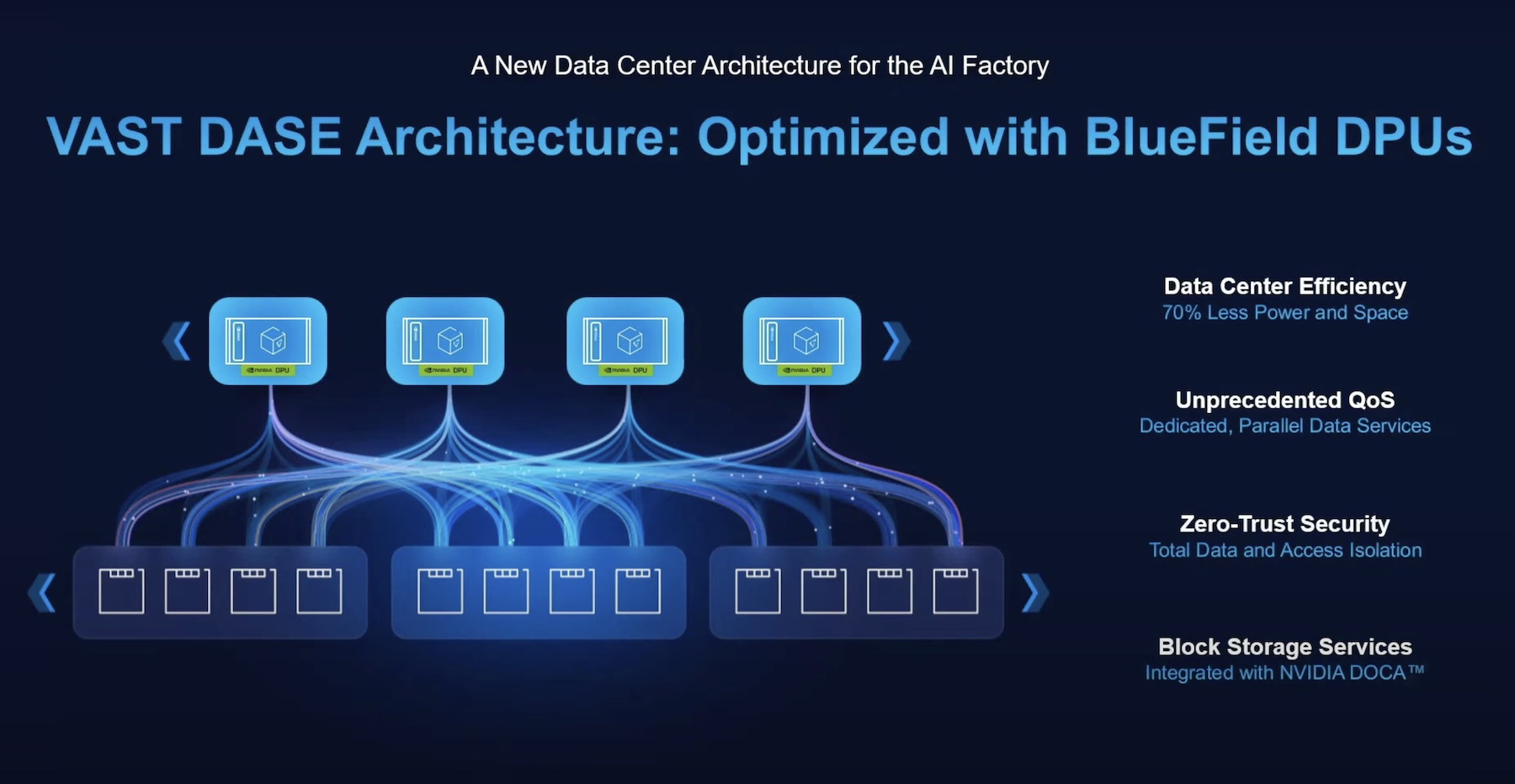As AI deployments continue to dominate the business scene, companies are recalibrating and adjusting their backend infrastructures to support AI’s lofty demands.
At the recent AI Field Day event, VAST Data presented a Showcase of their newly unveiled DASE (Disaggregated Shared Everything) architecture that cleverly offloads storage services on to DPUs. DASE is an AI cloud architecture that is built on the NVIDIA BlueField Networking Platform. The solution, VAST says, provides extreme performance and QoS for the AI factory.
Powered by the DASE architecture, the VAST Data Platform is a high-performance solution that brings together the best of parallel file system and network-attached storage (NAS). It is aimed at accelerating high performance computing (HPC), and is deployed at many notable organizations, including names like NASA, Harvard Medical School, and NIH.
John Mao, VP of Technology Alliance at VAST Data, and John Kim, Director of Storage Marketing for NVIDIA, gave a quick flyover of the new architecture and its highlights.
Inside the New VAST DASE Architecture
Under the hood, the VAST DASE architecture constitutes CNodes for compute, and DNodes for performance and capacity. Disaggregated, they can be scaled independently based on business requirements.
In the new architecture, the VAST CNodes are deployed on the 3rd generation NVIDIA BlueField DPUs residing inside the NVIDIA servers. This brings to life a holistic solution, that, for one, is mind-blowingly simply to operate, and for another, deliver tremendous cost savings.
“We’ve been fortunate to work with a lot of cloud service providers over the last months. We’ve had this idea in the works for quite some time now. We’ve customers like CoreWeave that have deployed this into production” Mao informs.
DPUs are becoming increasingly common in hyperscale infrastructures of late. “When you have a very large-scale cloud infrastructure where every server wants to have accelerated networking, storage, virtualization and encryption, DPUs make sense.”
An equally advantageous attribute of DPUs is functional isolation. DPUs afford these cloud providers the rare ability to offer a host of management and diagnostic functions off of them, without the use of additional container management systems. For tenants renting bare metal servers, “they can make that capability available without interfering with the tenants’ use of the server,” says Kim.
Parallel Data Services for Unprecedented QoS
The VAST architecture uses BlueField-3 DPUs. NVIDIA calls the platform “infrastructure-on-a-chip”. The DPUs provide a software-defined, hardware-accelerated infrastructure connected via Ethernet or InfiniBand. The BlueField DPUs work by offloading and isolating pieces of storage, networking, security and management functions, delivering much-improved efficiency all around.
“This solution, working together with VAST, is one way of bringing that storage and that data right to the compute layer where the GPUs are,” says Kim.

The VAST architecture design entails putting a dedicated NVIDIA DPU inside each GPU server. This allows storage and data processing to be embedded directly in the server unlocking linear data services available inside the client’s own PCIe bus, that can be scaled across thousands of GPUS. By letting each server have its own parallel storage and database container, the contention for data services is entirely bypassed. There is no sharing of the DPU with other machines. The dedicated parallel data services amount to unprecedented QoS.
By design, this architecture offers enhanced security. With data and data management isolated from the host operating systems, the software delivers a protected environment with data and access isolation. It can run NAS, object and database services off of the DPUs, without exposing the underlying protocols and platforms.
The existing VAST Data Platform CNodes are based on x86 hardware. Porting them over to the NVIDIA DPUs frees up a chunk of them that users can either rip out or use up. The free CPU cycles can be used to run AI or other management tasks unrelated to the storage, says Kim.
Trading the x86 servers for the NVIDIA DPUs instantly drops the overall physical and energy footprint of the VAST infrastructure by 70%. When compared to deploying NVIDIA-powered supercomputers with VAST, “the overall the energy savings nets out to be somewhere around 5% of datacenter power which when we are talking in megawatts, is not nothing. It’s a lot – hundreds of kilowatts that you could save by moving to this architecture and deployment model,” says Mao.
Be sure to watch the VAST Data Showcase with NVIDIA from the AI Field Day event for more information.

